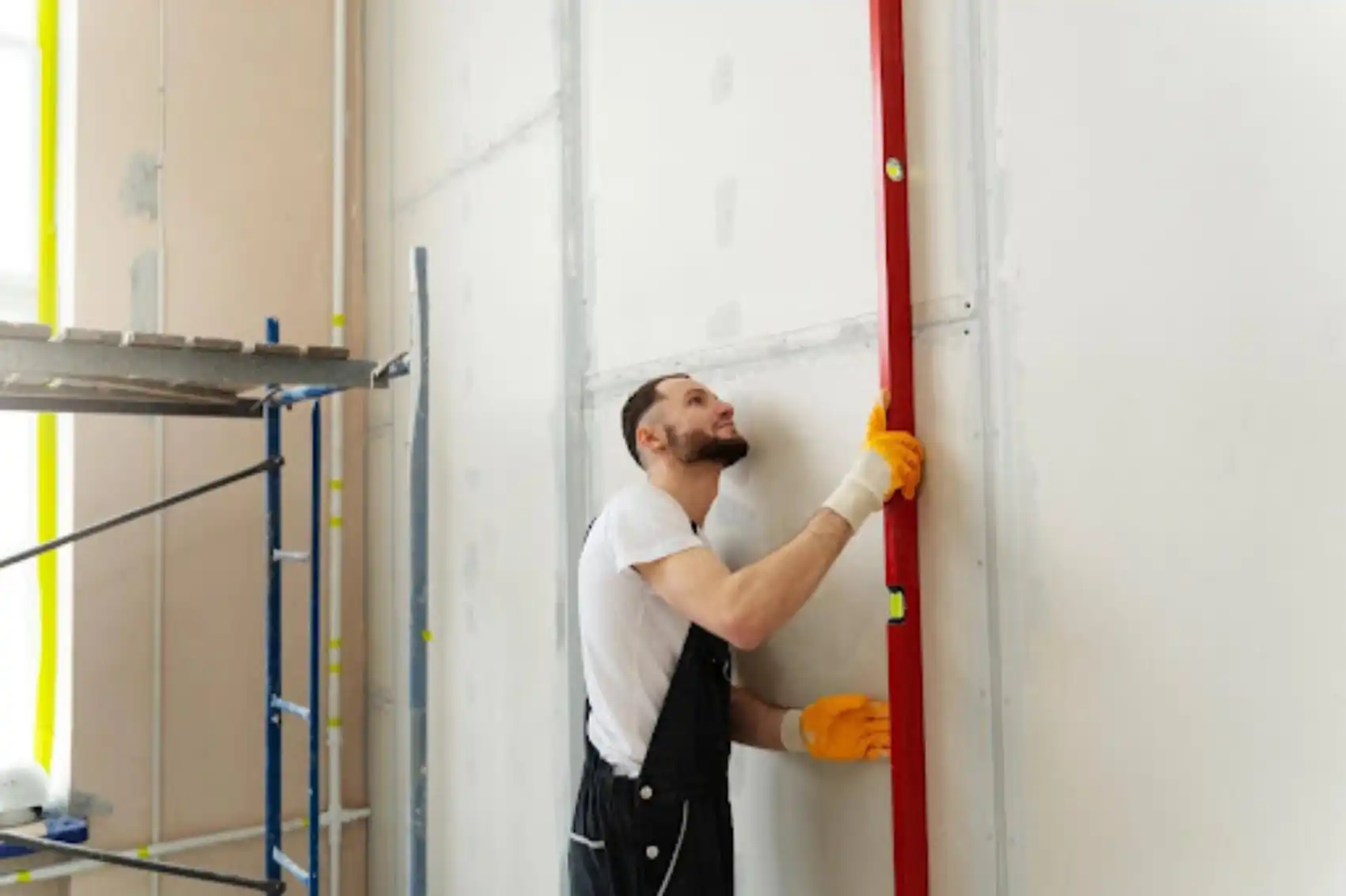
Regardless of your home project, from flat refurbishment to house extension and loft extension London, you probably want to enhance your property’s energy efficiency. Internal wall insulation is an effective means of improving energy efficiency. Combining insulation for internal walls with your construction projects offers dual benefits: It lowers heating loss and utility bills while increasing home comfort and market value.
This article explores the benefits and drawbacks of internal wall insulation for solid walls by discussing the least expensive methods for interior wall insulation and internal techniques for exterior wall insulation. This essential guide offers valuable data for anyone wanting to understand internal wall insulation options when renovating their London property even if they plan to have a professional do the work or choose to perform the work themselves.
Internal Solid Wall Insulation
The installation of insulation materials on external walls at their internal side constitutes internal insulation for solid walls. The technique reduces household heat loss while simultaneously increasing your home’s energy efficiency performance. The internal solid wall insulation material market consists primarily of three options: foam board, fiberglass, and cellulose.
Among all internal solid wall insulation choices Kingspan internal wall insulation stands out as a favored option. Kingspan delivers market-leading insulation products that provide outstanding thermal performance results.
Internal wall insulation requires different material selections based on physical building characteristics together with environmental conditions and individual user preferences. Still, some effective options are
- Kingspan internal wall insulation: This high-performance rigid insulation board provides installation within internal walls for its intended use.
- Fiberglass batts: The installation of these batts remains economical while offering ease of installation for cavity wall contexts.
- Cellulose insulation: The high-performance eco-friendly insulation material works well for tight installation spaces.
- Rigid foam insulation: Reliability and high performance characterize this material which allows cutting for applications surrounding electrical outlets and switches.
Cheapest Way to Insulate Internal Walls
For your flat refurbishment London and house extension London to loft extension, you need to consider economical methods to insulate walls internally. Internal wall insulation creates improved comfort while reducing heat loss and increasing energy efficiency in homes.
Option 1: Foam Board Insulation
Internal walls benefit most economically from insulation protection through foam internal wall insulation boards. You can adapt foam board insulation to your wall dimensions because it serves as an inflexible insulation material. Installing the foam board insulation yourself proves to be quite affordable beyond standard types of insulation products.
Option 2: Fiberglass Batts
To provide budget-friendly insulation for internal walls people can install fiberglass batts. The studs of your wall can accept fiberglass batts which represent a particular insulation option. These materials allow DIY homeowners to handle their installation independently because of their budget-friendly nature.
Additional Tips for Insulating Internal Walls on a Budget
When insulating internal walls on a budget, keep the following tips in mind:
- Choose the right insulation material: Insulation material selection depends on both wall type and climate zone conditions.
- Measure carefully: To acquire the proper quantity of insulation material measure your walls precisely.
- Install correctly: To guarantee the proper installation of insulation material you need to follow the manufacturer’s directions.
- Consider DIY installation: You can reduce your insulation costs when you take on the installation task yourself.
- Look for discounts and rebates: Contact your local manufacturing and hardware supply companies to learn about possible discounts for insulation products.
Combining budget-friendly insulation methods with low-cost internal wall options allows households to reach energy-efficient comfort levels at affordable costs.
Insulating External Wall Internally
External wall internal insulation projects require additional complexity in comparison to internal wall insulation efforts. Internal insulation represents a practical way to enhance your home’s energy efficiency ratings. Internal wall insulation of external walls requires a proper selection of insulation materials that work correctly with the exterior wall construction.
To insulate external walls internally you should use multiple insulation materials combined. A building solution involves dispersing foam board insulation beneath fiberglass batt insulation. The dual-layer system delivers top thermal efficiency while minimizing heat flow through walls.
Benefits of Insulating External Walls Internally
Insulating external walls internally can provide numerous benefits, including:
- Improved energy efficiency: Your utility costs decrease along with carbon emission reductions when you reduce heat loss.
- Increased comfort: The internal insulation of external walls creates better home comfort by improving temperature management.
- Reduced moisture accumulation: You can lower moisture accumulation risks and dampness threats when you use breathable insulation materials.
Popular Insulation Options
The insulation of external walls through interior placement requires multiple insulation materials combined for success. For example:
- Fiberglass batts should be installed after placing the foam board insulation. The insulation system produces excellent thermal performance and achieves superior heat retention.
- Fibrous cellulose insulation lies directly above rigid insulation panels. The combination delivers superior thermal performance while decreasing energy usage.
Insulating an Internal Wall
The process of wall insulation becomes less complex when you focus on internal walls instead of external ones. Two common interior wall insulation materials consist of foam board with fiberglass and cellulose.
When insulating internal solid walls the choice of Kingspan internal wall insulation has become one of the most popular methods available. Kingspan internal wall insulation achieves advanced thermal performance standards while also blocking noise transmission effectively.
Insulating interior walls can be beneficial in several ways:
- Reduced noise transmission: Insulation application when done correctly helps rooms achieve better soundproofing between adjacent rooms.
- Improved thermal comfort: Insulation operates as a system that controls heat shifts between different residential zones
- Energy efficiency: Insulation works to decrease building heat loss which in turn decreases energy usage.
- Increased property value: Properly insulated interior walls provide attractive benefits to property buyers.
Kingspan Internal Wall Insulation
The Kingspan insulation system has established itself as the preferred choice among London homeowners who want to enhance the energy efficiency of their properties during flat refurbishment London, house extensions, or loft extensions London. Built with superior thermal performance Kingspan internal wall insulation delivers both heat efficiency and reduced energy expenses and lowered carbon footprints to homeowners.
Benefits of Kingspan Internal Wall Insulation
Kingspan insulation for internal walls offers numerous benefits, including:
- High thermal performance: Kingspan internal wall insulation delivers remarkable thermal performance by stopping heat loss across walls while maintaining the house temperature.
- Easy installation: Kingspan internal wall insulation provides quick installation processes that suit self-installation projects.
- Durability: Kingspan internal wall insulation delivers both high durability and extended thermal performance together with prolonged energy benefits.
- Moisture resistance: The waterproof nature of Kingspan internal wall insulation defends walls from moisture which prevents both dampness and mold formation within structures.
Installation Requirements
Precise execution of installation requires thorough adherence to the manufacturer directives released by Kingspan for internal wall insulation. Careful attention to manufacturer instructions during installation will facilitate the proper placement of insulation material which maximizes its performance capabilities.
Some key installation requirements to keep in mind include:
- Cleaning and dusting the wall surface as well as checking it remains dry before applying insulation materials
- The necessary measurements of the wall need to be performed to guarantee proper insulation material cutting.
- The right methods should be applied for attaching insulation material to walls.
- To avoid moisture accumulation the walls need proper ventilation systems.
You can achieve maximum energy efficiency improvements through the installation of internal wall insulation systems. All London property owners who undertake flat refurbishments, house extensions, or loft extensions should consider implementing internal wall insulation because this approach reduces heat loss and creates improved comfort within their homes.
FAQs
What is the best insulation for internal walls?
Thermal and vibration insulation needs are best met with rigid Kingspan wall insulation boards that deliver outstanding thermal insulation along with acoustical control.
What type of insulation is best for interior walls?
Different interior wall requirements call for acoustic insulation and thermal insulation options where fiberglass batts together with spray foam insulation often present the optimal choices.
Is it a good idea to insulate interior walls?
Blowing insulation into interior walls may be beneficial because it improves sound reduction while boosting energy performance and interior comfort yet proper evaluation of moisture risk and fire regulations must occur.
Can internal wall insulation cause damp?
Insulated internal walls lead to damp problems when installed improperly especially when insulation professionals fail to provide sufficient ventilation appropriate installation and compatible materials causing water accumulation that results in dampness.




